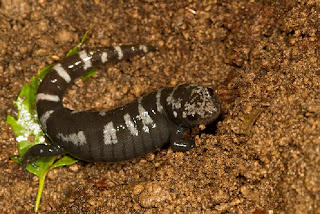By Kristina
McCullough, James River Master Naturalist
 |
| Marbled Salamander Photo by Gary Sargent |
It was a dark and stormy night…but on the morning of May 18
the sun shone brightly on the first inaugural Belmead Bioblitz in Powhatan
County. This intensive biological “discovery and documentation” of the property’s
plants and animals was organized by co-sponsors Francis-Emma and James River
Master Naturalists. Over 105 volunteers stepped up to register,
accept their assignments, and walk or be shuttled to their designated search
sectors. For the next 24 hours historic
Belmead mansion was a quiet hum of activity as leaders reported back their
findings. All day and night, packs of
roving experts walked, scrambled, waded, or crawled to spot their wildlife
quarry.
 |
| Grey Phase Eastern Screech Owl Photo by Julie Kacmarcik |
The atmosphere turned festive during the afternoon with
public education sessions where enthusiastic teachers and rehabilitators
introduced visitors to native wildlife.
When the rain let up, visitors poured down to the creek to watch a team
of ichthyologists in full waders scoop electrically shocked fish out of the
water for identification. Fifteen
minutes later, the fully recovered fish were swimming in their temporary home
while the experts completed their count of 26 species including a surprising American
eel and a pre-historic-looking long-nose gar.
 |
| Click Beetle Photo by Julie Kacmarcik |
As the long cool day turned into evening, final reports
trickled in from the different teams.
The macro-invertebrates group found 15 species of dragonflies, including
three county records with colorful names like Appalachian Jewelwing and
Carolina Saddlebags. Ornithologists
rushed in from around the property constantly updating the record board until
it held fast at a whopping 98 species of birds, including an elegant trio of
gray and white Mississippi Kites that put down in the storm. The botanists stuck it out until late evening
identifying a total of 212 unique plants and carefully preserving each in
massive presses to create an herbarium to document the diversity. The foresters were delighted by the huge
number of Osage Oranges on the property, a tree that was introduced to the East
Coast by Lewis and Clark and was often used as hedgerows between fields and
farms. The excitement continued late into the night with naturalists counting
nocturnal moths (including 10 rarely, if ever, reported in the state), owls,
and mammals.
 |
| Northern Brown Snake Photo by Gary Sargent |
By Sunday morning, peace and quiet had returned to Belmead
as the swarms of volunteers returned home for much-needed showers and
much-deserved rest. However, those tired
volunteers leave behind some noteworthy achievements: A legacy of teamwork
across multiple agencies and organizations; a contagious enthusiasm for the
great outdoors; and an encyclopedic accounting of the precious resident plants
and animals that make Belmead such a special place.
 |
| Turtle Photo by Richard Reuse DOF |
By the way, it just so happens that I heard more than muddy,
tired volunteer exclaim, ere they drove out of sight, “Hey, let’s do another
one!” so keep your eyes out for your chance to volunteer or learn at a future
Belmead Bioblitz!
The JRA RiverRats have
two Sisters on their crew, Sister Jean Ryan and Sister Elena Henderson. They
live at Belmead, home to the Sisters of the Blessed Sacrament, a beautiful
place on the banks of the James River in Powhatan County. Belmead recently held
its first Bioblitz and found an amazing array of life out there!
For more information
List of Species found during the Belmead Bioblitz
Visit the Belmead Facebook page to see more photos from the
day! https://www.facebook.com/FrancesEmmaBioblitzVirginia








